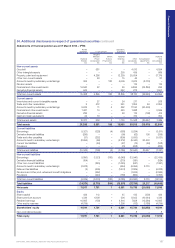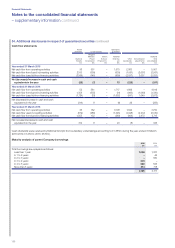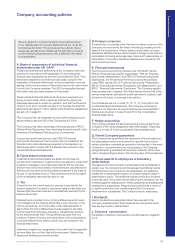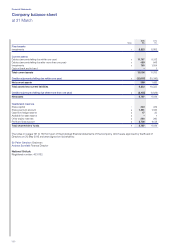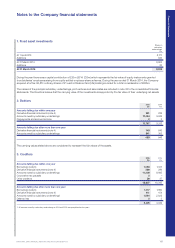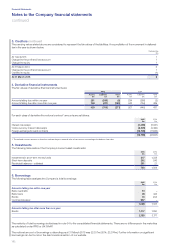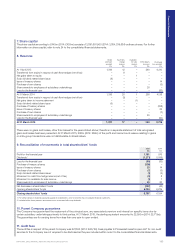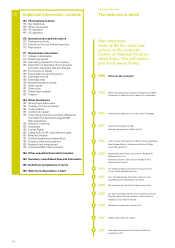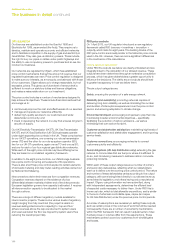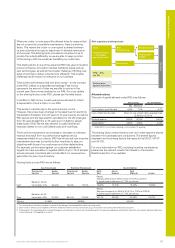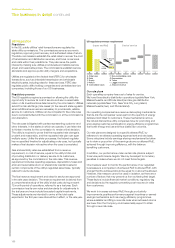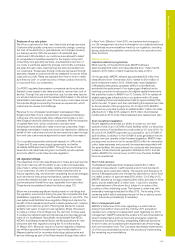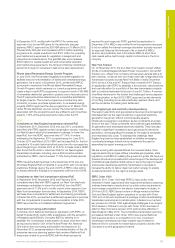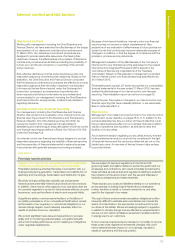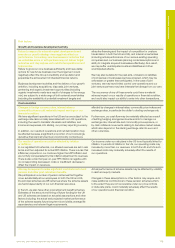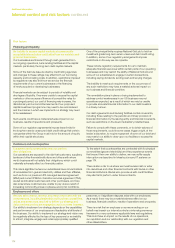National Grid 2015 Annual Report Download - page 169
Download and view the complete annual report
Please find page 169 of the 2015 National Grid annual report below. You can navigate through the pages in the report by either clicking on the pages listed below, or by using the keyword search tool below to find specific information within the annual report.
Where we under- or over-spend the allowed totex for reasons that
are not covered by uncertainty mechanisms, there is a sharing
factor. This means the under- or over-spend is shared between
usand customers through an adjustment to allowed revenues in
afuture year. This sharing factor provides an incentive for us to
provide the outputs efficiently, as we are able to keep a portion
ofthe savings, with the remainder benefiting our customers.
This sharing factor is one of the ways that RIIO has given innovation
more prominence. Innovation includes traditional areas such as
new technologies, as well as the broader challenge of finding new
ways of working to deliver outputs more efficiently. This broader
challenge has an impact on everyone in our business.
Totex is then split between fast and slow money – a new concept
under RIIO, based on a specified percentage. Fast money
represents the amount of totex we are able to recover in the
currentyear. Slow money is added to our RAV. For more details
onthe sharing factors under RIIO, please see the table below.
In addition to fast money, in each year we are allowed to collect
adepreciation of and a return on our RAV.
This works in a similar way to the previous price control.
However,there have been changes to the asset lives for electricity
transmission (transition from 20 years to 45 years evenly across the
RIIO period) and the depreciation calculation for UK GD (changed
from 45 years straight line to 45 years sum of digits for assets
added post 2002). We are also allowed to collect additional
revenues related to non-controllable costs and incentives.
The incentive mechanisms can increase or decrease our allowed
revenue and result from our performance against various
measuresrelated to our outputs. RIIO has introduced new incentive
mechanisms as a way to provide further incentives to align our
objectives with those of our customers and other stakeholders.
Forexample, performance against our customer satisfaction
targets can have a positive or negative effect of up to 1% of allowed
annual revenues. Incentives will normally affect our revenues two
years after the year of performance.
Allowed returns
The cost of capital allowed under RIIO is as follows:
Transmission Gas Distribution
Gas Electricity
Cost of equity (post-tax real) 6.8% 7. 0% 6.7%
Cost of debt (pre-tax real) iBoxx 10 year simple trailing average index
(2.92% for 2013/14)
Notional gearing 62.5% 60.0% 65.0%
Vanilla WACC14.38% 4.55% 4.24%
1. Vanilla WACC = cost of debt x gearing + cost of equity x (1- gearing).
The sharing factor means that any over- and under-spend is shared
between the businesses and consumers. The shared figures
displayed are the sharing factors that apply to the UK ET, UK GT
and UK GD.
For more information on RIIO, including incentive mechanisms,
please see the relevant investor fact sheets on the Investor
Relations section of our website.
RIIO regulatory building blocks
Revenue
Other costs
e.g. tax
Performance
against incentives
Totex
(capital invested
+ controllable
operating costs)
Allowed return
Depreciation
of RAV
RAV
(slow money)
Fast money
X
Sharing factors under RIIO are as follows:
Gas Transmission Electricity Transmission Gas Distribution
Transmission
Operator
System
Operator
Transmission
Operator
System
Operator
North
West
East of
England
West
Midlands London
Fast1
Baseline3 35.6%
62.60% 15.00% 72.10%
Repex:
Stepped decline from 50% in 2013/14 to 0% in 2020/21
in seven equal instalments of 7.14% per annum
Uncertainty 10% 73.90% 73.37% 75.05% 76.53%
Slow2
Baseline3 64.4%
37.40 % 85.00% 27. 9 0%
Repex:
Stepped increase from 50% in 2013/14 to 100% in 2020/21
in seven equal instalments of 7.14% per annum
Uncertainty 90% 26.10% 26.63% 24.95% 23.47%
Sharing 44.36% 46.89% 63.04%
1. Fast money allows network companies to recover a percentage of total expenditure within a one year period.
2. Slow money is where costs are added to RAV and, therefore, revenues are recovered slowly (e.g. over 20 years) from both current and future consumers.
3. The Baseline is the expenditure that is funded through ex ante allowances whereas the Uncertainty adjusts the allowed expenditure automatically where the level outputs delivered differ from
the baseline level, or if triggered by an event.
Additional Information
NATIONAL GRID ANNUAL REPORT AND ACCOUNTS 2014/15 167


